Corporate PPAs: Meaning, Benefits & Long-Term Corporate Risks
Corporate PPAs: Meaning, Benefits & Long-Term Corporate Risks
Discover the number one long-term risk in corporate PPAs and how Flexidao's energy management solutions can help mitigate it.
What is a Corporate PPA?
Corporate PPAs are a specific type of power purchase agreement where the power purchaser is a corporate entity, often seeking to meet sustainability or environmental targets. These agreements allow businesses to buy a certain amount of renewable energy from a power producer. Corporate PPAs can be structured as physical or virtual PPAs.
By entering into a corporate PPA, the purchasing company can secure a long-term supply of renewable energy at a predetermined price, providing stability and often cost savings over the contract duration.
Corporate PPAs are attractive to companies looking to reduce their carbon footprint, show environmental leadership, and hedge against future energy price volatility. They provide a direct way for businesses to support the development of renewable energy projects, driving the clean energy sector's growth.
Key Benefits of Corporate PPAs for Businesses
Corporate PPAs offer numerous benefits, including cost savings, sustainability, and energy independence. By locking in fixed energy prices, reducing carbon emissions, and mitigating risks associated with fossil fuel markets, corporate PPAs empower businesses to achieve their sustainability goals and enhance their bottom line.
The market for corporate PPAs, or Power Purchase Agreements, has grown significantly in the past decade. In 2010, just 0.1 GW of PPAs were signed by corporations. Since then, PPA capacity procured has grown 230-fold to 23 GW in 2020.

One risk that is typically overlooked is the risk of future changes to how the renewables certificate market interacts with the carbon market.
Source: Bloomberg NEF
There are many reasons why PPAs have seen such solid growth. In addition to reducing emissions for a company, PPAs typically offer a substantial price discount on electricity purchased through the wholesale market or supply tariffs. Fixed PPA pricing also offers budget certainty, reducing exposure to volatile energy markets. Additionally, PPAs will be a key component for sector coupling and power-to-X solutions which are emerging backed by the latest EU measures in the matter of environmental policy making. In fact, it is clear by now that, especially for Green Hydrogen, the EU will require strict deliverability requirements in order to ensure that the conversion of electrical power to new energy vectors (e.g. H2) doesn’t rely on fossil-based electricity production.
However, PPAs aren’t without their risks. By committing to a long-term contract, a company takes a risk on future prices in the energy market. Generally, we find that there is good awareness of the common risks of PPAs. Buyers understand risks related to project development, volume, and operational performance. However, one risk that is typically not considered is the impact that future changes and requirements for environmental reporting might have on PPAs. For more details on PPAs, check out our article, Purchasing Renewable Energy: Energy Products Compared.
What could change for Corporate PPAs?
To tackle the global climate crisis, the European Union is undertaking major reform to energy and carbon legislation. Central to these changes will be the update of the Renewable Energy Directive II (RED II). The European Commission (EC) initially opened a consultation round on changes to RED II in October 2020. In July 2021, the EC outlined its proposals for revision of RED II as part of the proposed Fit-for-55 law package.
Overall, electrification is clearly a pillar of Europe's Fit-for-55 which aims to achieve 55% GHG reductions. To make this possible, the EU is beginning to allude to a categorization of renewable energy procurement strategies based on carbon reduction impact and deliverability: wording such as "fully renewable electricity" were used in official documents, making direct reference to temporal and geographical correlation between production and consumption.
Future changes to Article 19
Regulators’ and market participants’ growing interest in deliverability linked to geographical and temporal correlation, is fostering new expectation and request for changes to the existing RED II Article 19 that regulates the GO scheme.
Organisations such as RE-Source, Europe’s leading forum for corporate renewable energy sourcing, had responded to the EU consultation requesting changes to the current Guarantee of Origin (GO) legislation under Article 19 of RED II. In their consultation response, they had specifically highlighted the transparency issues in the current GO framework. They stated:
“Corporate energy buyers and other consumers are increasingly seeking more detailed information on the origin of their energy. The framework should increase the level of transparency and information contained in GOs to support those consumers seeking to report on additional attributes…
…information pertaining to the time of generation could be provided at a more granular level than simply annually, to aid consumers to attest to the matching of supply and demand. The granularity of the information displayed on GOs would be aligned with the electricity market where the GO is issued. The shortest time unit for electricity trading is currently 15 minutes in Europe.”
While these proposed changes won't occur in this round of revisions, several regulated entities, such as M-RETs and Energinet, are already working to implement fractional and granular Energy Attributes Certificates and there is a high probability that the energy sector as a whole will embrace such change in the future. This could have a wider impact on the renewable energy market and corporate energy buyers.
Possible impact on PPAs
When a corporation signs a PPA with a renewable generator, they typically take the right to GOs or renewable attributes of the energy generated. Under the current GO scheme, corporations account for their carbon emissions from electricity on an annual basis. If renewable energy certificates and carbon accounting become hourly based, claiming 100 percent renewable energy through a PPA purchase and therefore zero carbon emissions would become much more challenging. Many offtakers will find themselves not having zero carbon emissions in their Scope 2 reporting.
Committing to purchasing from a specific energy generation curve from a plant could be a risk if you didn’t assess how it matches with your consumption profile. For example, a Solar PPA will not fully cover a business’s nighttime load. This means that the business will likely rely on fossil fuel electricity to operate during these hours.
The EC reference to "fully renewable" electricity may strongly impact the wider market of renewable electricity procurement, as it might represent the beginning of the creation of clear guidelines which assess the deliverability and true carbon reduction impact amongst the different renewable electricity procurement strategies. Beside that, REsource and other groups are already advocating for a revision of the current GOs scheme towards more granularity or think tanks like RMI are publishing papers on the relevance of procuring carbon-free electricity, around-the-clock.
What about renewable certificate pricing?
With the current GO framework, there is no financial incentive for companies to match energy consumption to production on an hourly basis. With the introduction of hourly matching, efficient pricing signals could be created which should drive investment of renewables and storage solutions on the local grid.
For example, if there is minimal renewable energy available during nighttime, the low supply could push up prices for certificates for this period. This would, in turn, incentivise investment in renewables that generate at night such as onshore wind.
With much more dynamic hourly pricing of GOs, companies would also need to be much more active in the renewable purchasing market. This would be necessary to reduce exposure to volatile pricing and allow for strategic purchasing of certificates.
What approach should I take as a buyer?
The market is still in transition and it's not clear yet how future energy and carbon legislation reforms will impact long-term PPAs. However, there are some options that energy purchasers can take to reduce future regulatory risk.
A key strategy when signing PPAs will be to monitor the matching score between generation to load, for at least two reasons:
- Mitigating the “shape risk”, that refers to the variable amount of power generated at different times (and at different prices). Companies with electricity usage spread out throughout the day and night (like a data center company) that are looking for a PPA to serve as a hedge against variable retail electricity prices might be concerned about the shape of the power generation under the PPA not matching the shape of their own electricity consumption.
- Being able to ensure the lowest carbon content in the electricity you are consuming, every hour of the day. This would have beneficial consequences on several fronts, ranging from adding a layer of credibility on the energy section of sustainability reports, to enabling powerful marketing campaigns that would confer the necessary, true and transparent green touch to a brand.
Some companies have already acknowledged that this strategy is required and are moving to hourly renewable energy accounting to reduce risk. For example, Google and Microsoft plan to procure 24/7 renewable energy to match its global demands by 2030.
Initial steps to 24/7 renewable energy
The first step for any company that begins its path towards 24/7 matching is to understand its “24/7 score” or “hourly gap”, through analysing its consumption profile and renewable energy sourcing profile - similarly to what Google did by calculating their Carbon-Free Energy Score (CFE). The granularity of these two profiles must be as high as possible, in order to have the required analytical precision.
The second step is to use this granular data to plan the improvement of the renewable energy procurement strategy, filling the carbon-intensive gaps that are not covered by the existing PPA. With the collected data, the company will finally be able to select the best fit amongst all the available renewable energy products offered in the market (PPA, GOs, Green Tariffs, etc.)
Software solution for 24/7 renewable energy purchases
Executing the two steps mentioned above can be extremely challenging - it took Google over 3 years to map their CFE. It is for this reason that at FlexiDAO we provide software solutions to help companies monitor their renewable energy procurement data on a 24/7 basis. We also help in the decision-making process when investing in long-term supply options (PPAs, self-consumption and other renewable market products). In fact, our solution can measure historical gaps between hourly green energy production and your hourly consumption to progress towards 24/7 zero-carbon energy.
Our software is built based on our experience working at the forefront of change in the renewable energy markets. Through our partnership with new initiatives like EnergyTag, we have first-hand exposure to changes in energy and carbon certificate markets. As part of the EnergyTag initiative, we’re trialing 24/7 renewable hourly matching (24/7) for an 11 MW electric boiler in the Netherlands giving us first-hand involvement with this new purchasing approach.
With FlexiDAO you can ensure that your renewable energy purchases are futureproofed from the very start and any future regulatory risk is minimised.
If you would like more information on how our software can help your renewable energy purchasing strategy, please get in contact with our team


.webp)





